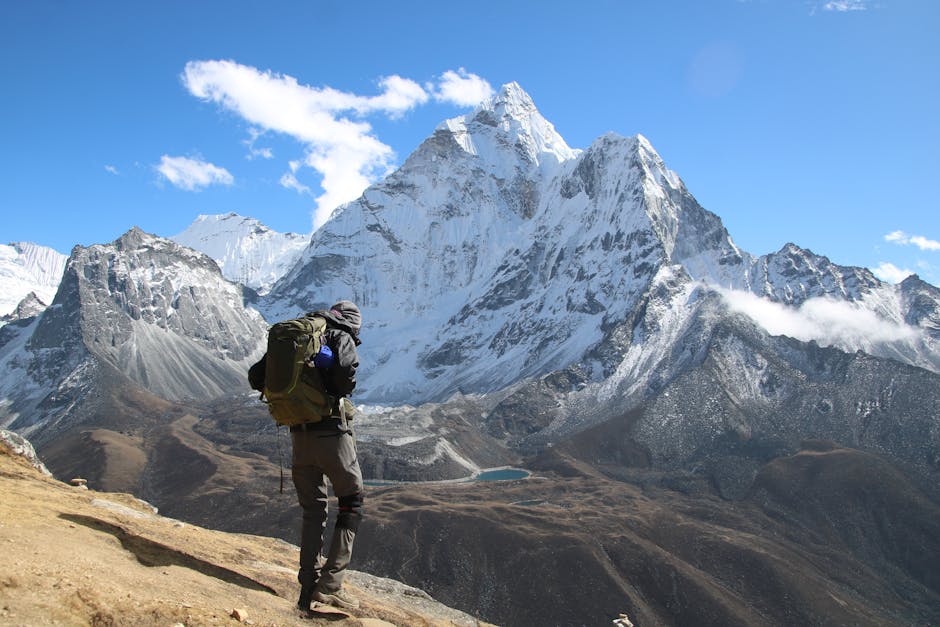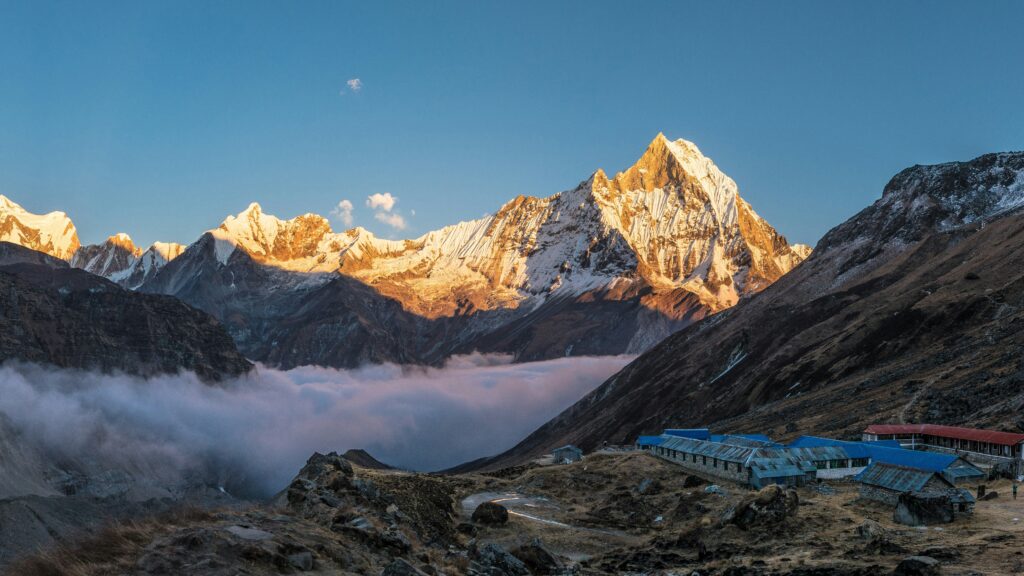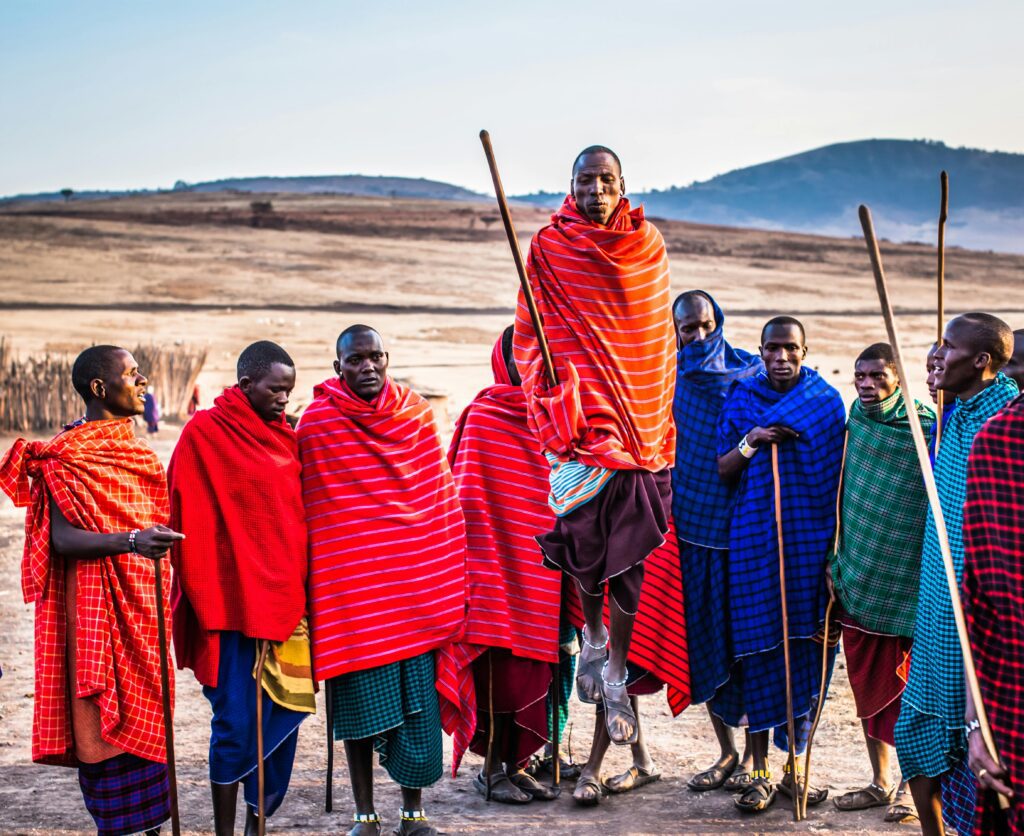“Discover hidden gems at Everest Base Camp, Nepal. Uncover unique, off-the-beaten-path experiences missed by most tourists. Unleash your adventurous spirit!”
Standing at the foot of the world’s highest peak, the thin air and biting wind couldn’t dull my exhilaration. Everest Base Camp, Nepal, was no longer a dream—it was my reality. Every year, thousands trek here, crossing suspension bridges draped in prayer flags, staying in cozy teahouses, and immersing themselves in Sherpa culture.
This guide covers everything you need—best times to visit, a detailed 12-day itinerary, cultural insights, pro tips, and much more—to plan your adventure.

Why Trek to Everest Base Camp?
Trekking to Everest Base Camp (EBC) is more than just a hike; it’s a transformative journey through some of the most breathtaking landscapes on Earth. Here’s why it should be on your bucket list:
- Bucket-list achievement: Standing at 5,364 meters (17,598 feet), you’ll be higher than most peaks in Europe. The sense of accomplishment is unparalleled.
- Cultural immersion: The Khumbu region is home to the Sherpa people, whose warmth and resilience are as inspiring as the mountains. Villages like Namche Bazaar and Tengboche offer glimpses into their traditions.
- Stunning landscapes: From lush rhododendron forests to the stark beauty of the Khumbu Icefall, every day on the trail brings new vistas.
- Spiritual connection: The region is dotted with monasteries, stupas, and prayer wheels, offering moments of reflection amid the physical challenge.
Pro Tip: Train for endurance and altitude. Slow pacing is key—rushing increases the risk of altitude sickness.
Best Time to Visit Everest Base Camp
Ideal Seasons
- Spring (March–May): Clear skies, blooming rhododendrons, and warmer days (5°C to 15°C). This is peak season, so trails and teahouses can be busy.
- Autumn (September–November): Crisp air, stable weather, and post-monsoon clarity. The views are unparalleled, and temperatures range from -5°C to 15°C.
Avoid
- Monsoon (June–August): Slippery trails, leeches, and obscured mountain views. Flights to Lukla are often delayed or canceled.
- Winter (December–February): Extreme cold (-10°C to -20°C at night), but fewer crowds. Only experienced trekkers should attempt this season.
Personal Anecdote: In October, I woke before dawn to hike Kala Patthar. As the sun rose, golden light spilled over Everest’s summit, while prayer flags fluttered in the icy wind. The silence was broken only by the occasional crunch of snow underfoot—a moment of pure magic.
12-Day Everest Base Camp Itinerary
For those short on time, this condensed itinerary covers the highlights. However, a 12–14 day trek is recommended for proper acclimatization.
Day 1: Kathmandu (1,400m) → Lukla (2,860m) → Phakding (2,610m)
- Morning: Scenic 35-min flight to Lukla’s thrilling mountain airstrip
- Hidden Gem: Visit the “Thank You Stupa” built by Lukla locals to honor climbers
- Afternoon: Gentle 3-hr descent through pine forests to Phakding
- Evening: Riverside teahouse stay with first taste of momo dumplings
Where to Stay: Hotel Namche offers cozy rooms with mountain views. Try their garlic soup—a local remedy for altitude sickness.

Day 2: Phakding → Namche Bazaar (3,440m)
- Morning: Cross 5 suspension bridges draped in prayer flags
- Cultural Stop: Receive blessing at Monjo’s ancient mani wall
- Afternoon: Steep climb to Namche with first Everest glimpses
- Evening: Explore the vibrant Saturday market (if timed right)
Day 3: Namche Acclimatization
- Sunrise Hike: Everest View Hotel (3,880m) for coffee with Ama Dablam panorama
- Offbeat Discovery: Khumjung village’s “yeti scalp” at Hillary School
- Afternoon: Sherpa Culture Museum & Sagarmatha Next sustainability center
- Evening: Garlic soup tasting (altitude remedy) at local teahouse
Need a detailed plan? Pls contact us.
Day 4: Namche → Tengboche (3,860m)
- Morning: Trail with rhododendron forests and mountain vistas
- Spiritual Highlight: Tengboche Monastery chanting ceremony (3PM)
- Photography Tip: Golden hour views of Everest from teahouse windows
- Evening: Stargazing in Nepal’s clearest night skies
Day 5: Tengboche → Pangboche (3,985m) → Dingboche (4,410m)
- Hidden Monastery: Visit Pangboche’s oldest gompa in Khumbu
- Rare Artifact: See the purported yeti hand at Pangboche Monastery
- Afternoon: Enter Imja Valley’s high-altitude landscapes
- Evening: Yak herder storytelling session in Dingboche
Day 6: Dingboche Acclimatization
- Sunrise Hike: Nangkartshang Peak (5,083m) for 360° mountain views
- Alternative: Chhukung Valley glacier walk (less crowded route)
- Afternoon: Stone wall farming demonstration with locals
- Wellness: Learn pressure-point techniques for altitude headaches
Day 7: Dingboche → Thukla (4,620m) → Lobuche (4,940m)
- Memorial Stop: Thukla Pass’s poignant climber memorials
- Silent Tribute: Hang prayer flag for lost mountaineers
- Geology Lesson: Observe glacial moraines en route to Lobuche
- Evening: Oxygen-level awareness talk by experienced guides
Day 8: Lobuche → Gorak Shep (5,164m) → EBC (5,364m)
- Morning: Trek through lunar-like Khumbu Glacier terrain
- Base Camp: 2-3 hours at Everest Base Camp (season depending)
- Hidden Perspective: View the Khumbu Icefall’s blue seracs
- Evening: Sunset on Nuptse’s face from Gorak Shep
Day 9: Kala Patthar (5,545m) → Pheriche (4,240m)
- Pre-Dawn: Summit Kala Patthar for sunrise over Everest
- Photographer’s Secret: Stay 30 mins post-sunrise for best lighting
- Descent: Visit Himalayan Rescue Association clinic in Pheriche
- Evening: Documentary screening on Sherpa mountaineering history
Day 10: Pheriche → Pangboche (3,985m)
- Rehydration Focus: Learn about altitude recovery strategies
- Buddhist Ritual: Participate in butter lamp offering ceremony
- Culinary Class: Momo-making workshop with Sherpa family
- Evening: Folk songs around the bukhari (wood stove)
Day 11: Pangboche → Namche (3,440m)
- Forest Therapy: Descend through fragrant juniper and rhododendron
- Conservation: Trail cleanup initiative (carry a trash bag)
- Sweet Stop: Everest Bakery’s apple pie reward in Tengboche
- Evening: Celebration dinner with chang (local barley beer)
Day 12: Namche → Lukla (2,860m)
- Final Descent: Re-cross suspension bridges with new perspective
- Legacy Project: Plant a tree with locals’ reforestation program
- Evening: Lukla farewell party with trekking crew
- Next Morning: Flight to Kathmandu
Essential Tips for Trekking
Packing List
- Clothing: Thermal base layers, down jacket, waterproof pants, and a warm hat. Temperatures swing drastically between day and night.
- Gear: Trekking poles (lifesavers on steep descents), sturdy boots (break them in beforehand!), and a reusable water bottle with a insulator sleeve to prevent freezing.
- Extras: Diamox (for altitude), wet wipes (teahouse showers are scarce), and a solar charger (outlets are pay-per-use).
Permits & Costs
- Sagarmatha National Park Permit: NPR 3,000 (~$25) from Kathmandu or Monjo.
- TIMS Card: NPR 2,000 (~$17) for independent trekkers; NPR 1,000 (~$8) for those with guides.
- Budget: $1,200–$1,800 for guides, food, and lodging. Teahouses cost $5–$15/night; meals are $5–$10 each.
Pro Tip: Carry cash—ATMs stop after Namche, and credit cards are useless in the mountains.
Cultural Experiences
Sherpa Hospitality
- Sip suja (butter tea) in a local home. The salty, creamy drink is an acquired taste but warms you from the inside out.
- Learn basic phrases: “Tashi delek” (hello), “Dhanyabad” (thank you), and “Nga Everest Base Camp jane” (I’m going to Everest Base Camp).
Must-Try Foods
- Dal Bhat: A trekker’s staple—unlimited refuels keep you going. The lentil curry, rice, and pickled vegetables vary by teahouse.
- Sherpa Stew: Hearty yak meat and vegetable soup, perfect for cold nights.
- Tibetan Bread: Fried dough served with honey or jam—carb-loading at its finest.
Personal Anecdote: In Dingboche, a Sherpa family invited me into their kitchen to fold momos. Mine were lumpy, but the laughter and shared meal made it a highlight of the trip.

FAQs
1. Can beginners do the trek?
Yes, but preparation is key. Train for 6–8 weeks with hiking, stair climbing, and cardio. Altitude is the real challenge—listen to your body.
2. Is Wi-Fi available?
Spotty. Buy teahouse Wi-Fi cards (~$5/hour), but expect slow speeds. Better to disconnect and embrace the mountains.
3. How dangerous is altitude sickness?
Very real. Symptoms include headaches, nausea, and dizziness. Acclimatize properly (don’t ascend more than 300–500m/day) and hydrate (3–4 liters daily).
4. Are guides mandatory?
No, but recommended. Guides handle permits, logistics, and emergencies. Porters can carry your pack (~$20/day).
5. What’s the hardest part?
The ascent to Gorak Shep—thin air and steep trails test even seasoned trekkers.
Final Thoughts
Everest Base Camp isn’t just a trek; it’s a pilgrimage. Whether you seek adventure or introspection, this journey will redefine your limits.
Start planning your Everest Base Camp, Nepal adventure today!
Keywords:
1. “Everest Base Camp trekking Nepal”
2. “Best time to visit Everest Base Camp for trekking”
3. “What to expect on Everest Base Camp trek Nepal”
4. “Everest Base Camp Nepal: A comprehensive travel guide”
5. “Top attractions and activities near Everest Base Camp Nepal”



